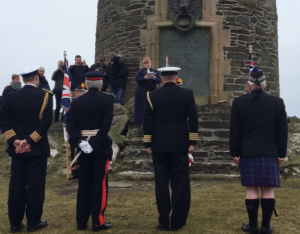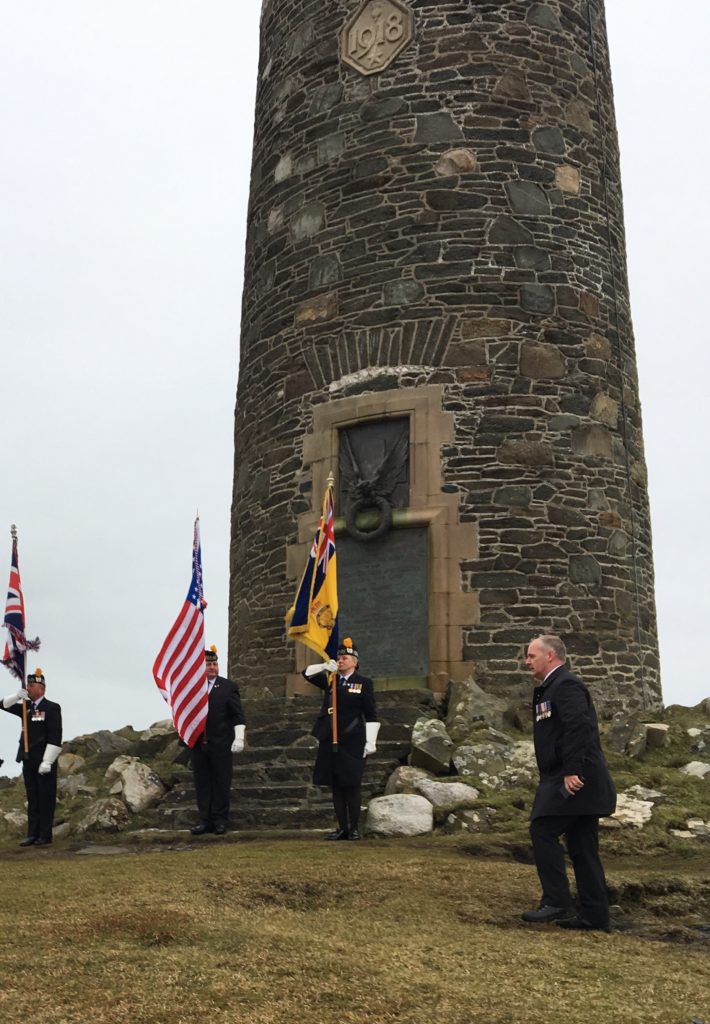On May 4, Islay, Scotland commemorated the 100th anniversary of the island’s role in World War I. The first event was a moving commemoration on a cold, windy cliff—the Mull of Oa. With standard bearers, bagpipes, and warships representing the UK, France, Germany and the U.S., people gathered to remember the Tuscania and the Otranto, ships that met a tragic end while carrying U.S. troops bound for the frontlines in France. I was honored to represent the American Red Cross at the service.
The Tuscania Torpedoed
The Tuscania had just entered the North Channel between Ireland and Scotland and was presumed safe before it was torpedoed by a German U-boat on February 5th, 1918. Some of the U.S. troops boarded a rescue boat, but others ended up in life boats.
The life boats struggled against rough currents and many of them crashed on the reefs of Islay. Given the remote location and suddenness of the tragedy, the rescue efforts fell to the island residents. There were 182 casualties, some pulled from the water and others washed ashore. Survivors were taken care of by locals who gave them food and clothing and prepared the victims for burial.
American Red Cross representatives arrived from London to assess the needs of the surviving U.S. troops. The Red Cross secured supplies from local sources, which included clothes, toiletries, cigarettes and chocolate. The British Red Cross, the British Military and private citizens all pitched in to help provide for the U.S. soldiers and British crewmen. The local resident’s response was heroic and generous, refusing any reimbursement from the Red Cross.
After the tragic attack in February, the Red Cross established emergency stations on the North Coast of Ireland and created a network of small supply substations. They arranged for transportation including cars and a ship to quickly move people and supplies. Little did they know, the response system would be tested just a few months later with the wreck of the Otranto on October 6, 1918.
The Otranto Collision
A raging storm hit a troop ship convoy and navigation became difficult causing the Otranto to collide with another ship. There were dramatic rescues and casualties along the coast line as the Otranto crashed onto rocks near the entrance to Machir Bay. Once again, the locals responded pulling the survivors and the dead from the water. The relief system implemented by the Red Cross was set in motion and supplies and support were quickly available. The Otranto is considered one of the worst accidents involving a troop ship during World War I with over 400 casualties.
In all, the island’s residents buried over 700 U.S. soldiers, British crewman, and a handful of French fisherman who boarded the Otranto when their ship sank.
The American Red Cross wanted a memorial to remind people of the sacrifices made on the coast of Islay, so the organization commissioned the monument on the Mull of Oa, overlooking the spot where the Tuscania sank.
Today, the sturdy tower still stands in memory of the wartime losses and is protected by Historic Environment Scotland, an entity established by the Scottish Government.


